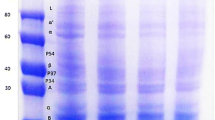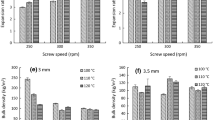Abstract
The objective of this study was to investigate the effect of soy protein isolate on functional properties and consumer acceptance of gluten-free rice spaghetti (GFRS) made from rice flour. Dry-milled high-amylose (Chai Nat 1) rice flour was premixed with dry-milled waxy (RD 6) rice flour at a ratio of 90:10 (w/w) with the soy protein isolate (SPI) concentration varying between 0, 2.5, 5.0, 7.5, 10.0 %, db. The GFRS formulation was processed using a co-rotating twin-screw extruder up to 95 °C with a screw speed of 220 rpm, 32 % moisture content, and then dried at 40 °C. The GFRS samples were analyzed by differential scanning calorimetry (DSC), X-ray diffraction, scanning electron microscopy (SEM) and texture parameters. Increasing SPI decreased the starch retrogradation of GFRS, whereas the enthalpy change of the amylose–lipid complex increased and crystallinity decreased. SEM revealed that the surface of GFRS containing SPI was much more porous than that of GFRS without SPI. The cooked GFRS containing 5.0 % SPI showed the best eating quality with increased firmness and tensile strength, and decrease stickiness. The GFRS samples were evaluated on the bases of cooking qualities and sensory evaluation. The results showed that the GFRS containing 5.0 % SPI decrease the cooking time from 17.6 to 13.7 min and cooking loss from 25.4 to 17.0 %. Overall acceptability of cooked GFRS containing 5.0 % SPI was the highest among all GFRS samples.



Similar content being viewed by others

References
AACC (2010) Approved methods of analysis. 11th ed. Method 66-50.01. St. Paul, Minnesota
Altan A, McCarthy KL, Maskan M (2009) Effect of extrusion cooking on functional properties and in vitro starch digestibility of barley-based extrudates from fruit and vegetable by-products. J Food Sci 74:E77–E86
D’Egidio MG, Mariani BM, Nardi S, Novaro P, Cubadda R (1990) Chemical and technological variables and their relationships: a predictive equation for pasta cooking quality. Cereal Chem 67:275–281
Detchewa P, Thongngam M, Naivikul O (2012) Physicochemical and thermal properties of non-waxy rice flour as affected by waxy rice flour and its influence on textural and cooking properties of rice spaghetti. Int Proc Chem Biol Environ Eng 39:235–239
Fardet A, Abecassis J, Hoebler C, Baldwin PM, Buléon A, Bérot S, Barry JL (1999) Influence of technological modifications of the protein network from pasta on in vitro starch degradation. J Cereal Sci 30:133–145
Faubion JM, Hoseney RC (1982) High-temperature short-time extrusion cooking of wheat starch and flour. II. Effect of protein and lipid on extrudate properties. Cereal Chem 59:533–537
Friedman M, Brandon DL (2001) Nutritional and health benefits of soy proteins. J Agric Food Chem 49:1069–1086
Fu BX (2008) Asian noodles: history, classification, raw materials, and processing. Food Res Int 41:888–902
Gujral N, Freeman HJ, Thomson ABR (2012) Celiac disease: prevalence, diagnosis, pathogenesis and treatment. World J Gastroentero 18:6036–6059
Hongspabhas P (2010) Structure changes of multiphase food systems generated by proteins. In: Devahastin S (ed) Physicochemical aspects of food engineering and processing. CRC Press, New York, pp 257–281
Kim Y, Kee JI, Lee S, Yoo S-H (2014) Quality improvement of rice noodle restructured with rice protein isolate and transglutaminase. Food Chem 145:409–416
Lamberts L, Gomand SV, Derycke V, Delcour JA (2009) Presence of amylose crystallites in parboiled rice. J Agric Food Chem 57:3210–3216
Lian X, Zhu W, Wen Y, Li L, Zhao X (2013) Effects of soy protein hydrolysates on maize starch retrogradation studied by IR spectra and ESI-MS analysis. Int J Biol Macromol 59:143–150
Marchylo BA, Dexter JE (2001) Pasta production. In: Owens G (ed) Cereals processing technology. Woodhead Publishing Limited, New York, pp 109–130
Marco C, Rosell CM (2008) Effect of different protein isolates and transglutaminase on rice flour properties. J Food Eng 84:132–139
Marti A, Pagani MA (2013) What can play the role of gluten in gluten free pasta? Trends Food Sci Technol 31:63–71
Matsuo RR, Dexter JE, Dronzek BL (1978) Scanning electron microscopy study of spaghetti processing. Cereal Chem 55:744–753
Moron B, Cebolla A, Manyani H, Alvarez-Maqueda M, Megias M, Thomas MDC, Lopez MC, Sousa C (2008) Sensitive detection of cereal fractions that are toxic to celiac disease patients by using monoclonal antibodies to a main immunogenic wheat peptide. Am J Clin Nutr 87:405–414
Niewinski MM (2008) Advances in celiac disease and gluten-free diet. J Am Diet Assoc 108:661–672
Patindol J, Wang Y-J, J-l Jane (2005) Structure-functionality changes in starch following rough rice storage. Starch-Stärke 57:197–207
Primo-Martín C, Nieuwenhuijzen NH, Hamer RJ, Vliet T (2007) Crystallinity changes in wheat starch during the bread-making process: starch crystallinity in the bread crust. J Cereal Sci 45:219–226
Shevkani K, Singh N (2014) Influence of kidney bean, field pea and amaranth protein isolates on the characteristics of starch-based gluten-free muffins. Int J Food Sci Technol 49:2237–2244
Shevkani K, Kaur A, Kumar S, Singh N (2015) Cowpea protein isolates: functional properties and application in gluten-free rice muffins. LWT-Food Sci Technol 63:927–933
Singh N, Shevkani K, Kaur A, Thakur S, Parmar N, Singh Virdi A (2014) Characteristics of starch obtained at different stages of purification during commercial wet milling of maize. Starch-Starke 66:668–677
Song Y, Jane J (2000) Characterization of barley starches of waxy, normal, and high amylose varieties. Carbohyd Polym 41:365–377
Sudha ML, Leelavathi K (2012) Effect of blends of dehydrated green pea flour and amaranth seed flour on the rheological, microstructure and pasta making quality. J Food Technol 49:713–720
Takahashi S, Hirao K, Watanabe T (1986) Effect of added soybean protein on physico-chemical properties of starch noodles (harasame). J Jpn Soc Starch Sci 33:10
U.S. Food and Drug Administration (2015) Federal register. Final rule; Document 78 FR 47154: Food labeling: gluten-free labeling of foods. https://www.federalregister.gov/articles/2013/08/05/2013-18813/food-labeling-gluten-free-labeling-of-foods. Assessed 30 September 2015
Wang N, Bhirud PR, Sosulski FWR, Tyler T (1999) Pasta-like product from pea flour by twin-screw extrusion. J Food Sci 64:671–678
Zweifel C, Conde-Petit B, Escher F (2000) Thermal modifications of starch during high-temperature drying of pasta. Cereal Chem 77:645–651
Zweifel C, Handschin S, Escher F, Conde-Petit B (2003) Influence of high-temperature drying on structural and textural properties of durum wheat pasta. Cereal Chem 80:159–167
Acknowledgments
The authors would like to thank The Royal Golden Jubilee Ph.D. Program (Contract No. PHD/0198/2549), The Thailand Research Fund, for financial support. We also wish to thank Professor Harry T. Horner and Tracey M. Pepper at Bessey Microscopy Facility, Iowa State University, U.S.A., for the fluorescent microscope study.
Author information
Authors and Affiliations
Corresponding author
Rights and permissions
About this article
Cite this article
Detchewa, P., Thongngam, M., Jane, JL. et al. Preparation of gluten-free rice spaghetti with soy protein isolate using twin-screw extrusion. J Food Sci Technol 53, 3485–3494 (2016). https://doi.org/10.1007/s13197-016-2323-8
Revised:
Accepted:
Published:
Issue Date:
DOI: https://doi.org/10.1007/s13197-016-2323-8



